Public Health - Assignment PDF
VerifiedAdded on 2022/01/03
|17
|3605
|18
AI Summary
Contribute Materials
Your contribution can guide someone’s learning journey. Share your
documents today.
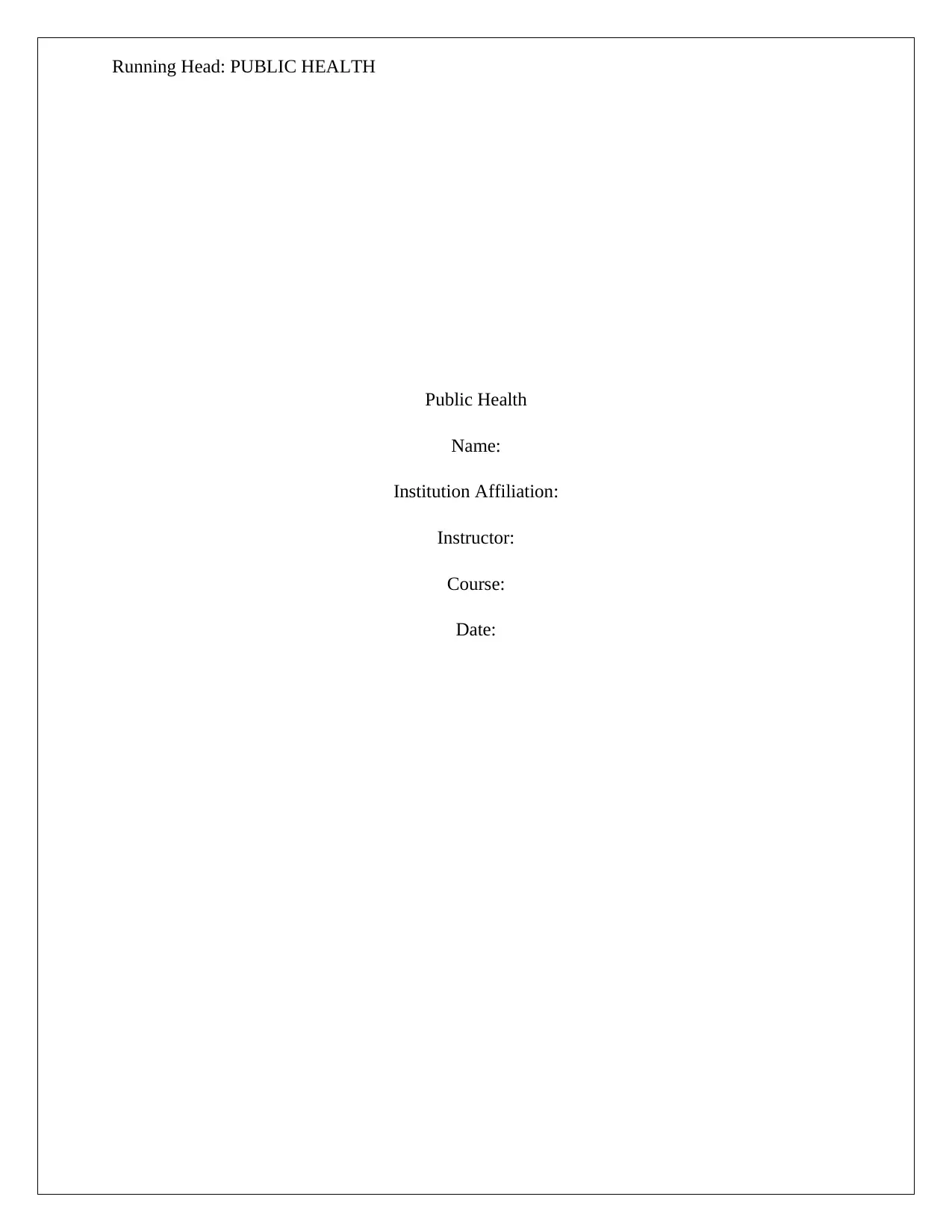
Running Head: PUBLIC HEALTH
Public Health
Name:
Institution Affiliation:
Instructor:
Course:
Date:
Public Health
Name:
Institution Affiliation:
Instructor:
Course:
Date:
Secure Best Marks with AI Grader
Need help grading? Try our AI Grader for instant feedback on your assignments.
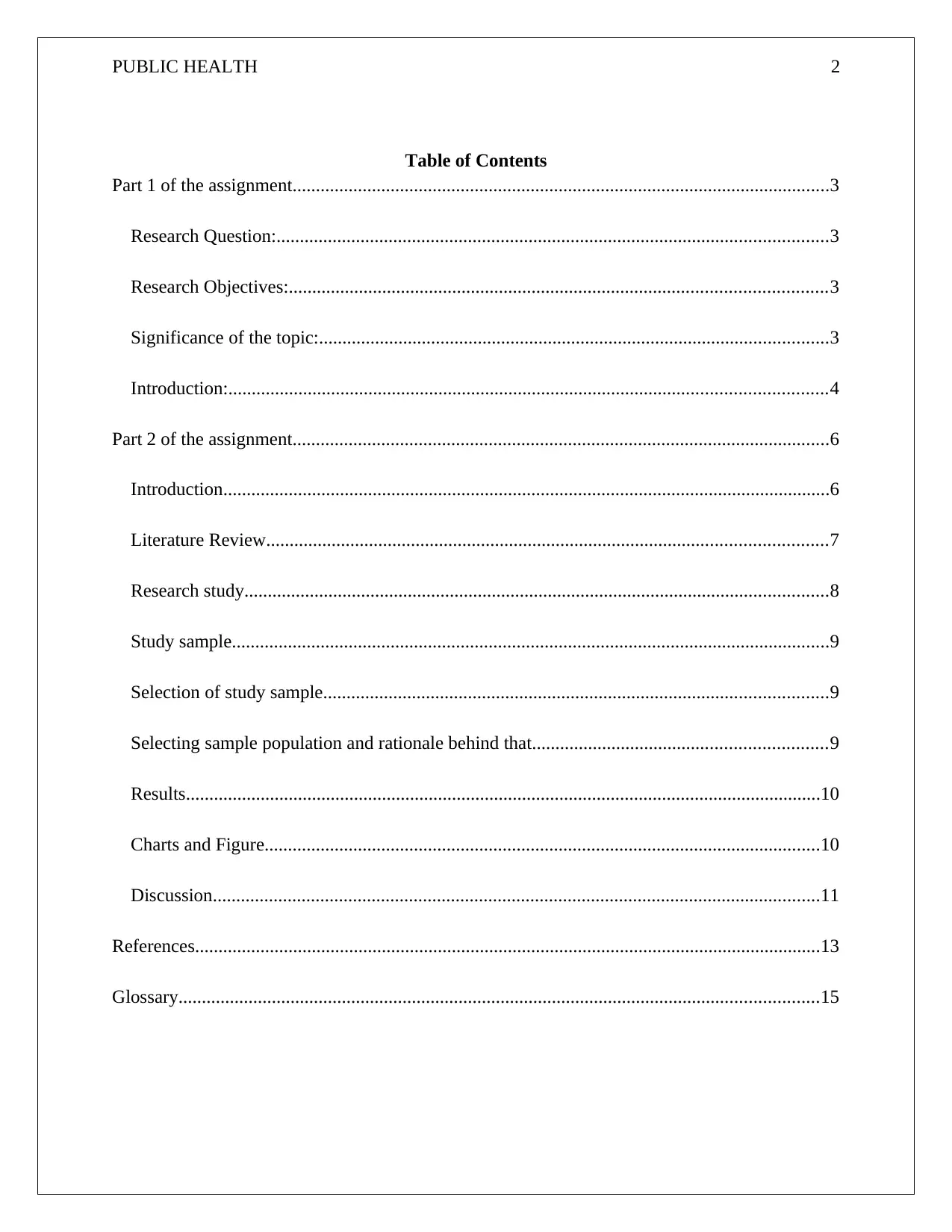
PUBLIC HEALTH 2
Table of Contents
Part 1 of the assignment...................................................................................................................3
Research Question:......................................................................................................................3
Research Objectives:...................................................................................................................3
Significance of the topic:.............................................................................................................3
Introduction:................................................................................................................................4
Part 2 of the assignment...................................................................................................................6
Introduction..................................................................................................................................6
Literature Review........................................................................................................................7
Research study.............................................................................................................................8
Study sample................................................................................................................................9
Selection of study sample............................................................................................................9
Selecting sample population and rationale behind that...............................................................9
Results........................................................................................................................................10
Charts and Figure.......................................................................................................................10
Discussion..................................................................................................................................11
References......................................................................................................................................13
Glossary.........................................................................................................................................15
Table of Contents
Part 1 of the assignment...................................................................................................................3
Research Question:......................................................................................................................3
Research Objectives:...................................................................................................................3
Significance of the topic:.............................................................................................................3
Introduction:................................................................................................................................4
Part 2 of the assignment...................................................................................................................6
Introduction..................................................................................................................................6
Literature Review........................................................................................................................7
Research study.............................................................................................................................8
Study sample................................................................................................................................9
Selection of study sample............................................................................................................9
Selecting sample population and rationale behind that...............................................................9
Results........................................................................................................................................10
Charts and Figure.......................................................................................................................10
Discussion..................................................................................................................................11
References......................................................................................................................................13
Glossary.........................................................................................................................................15
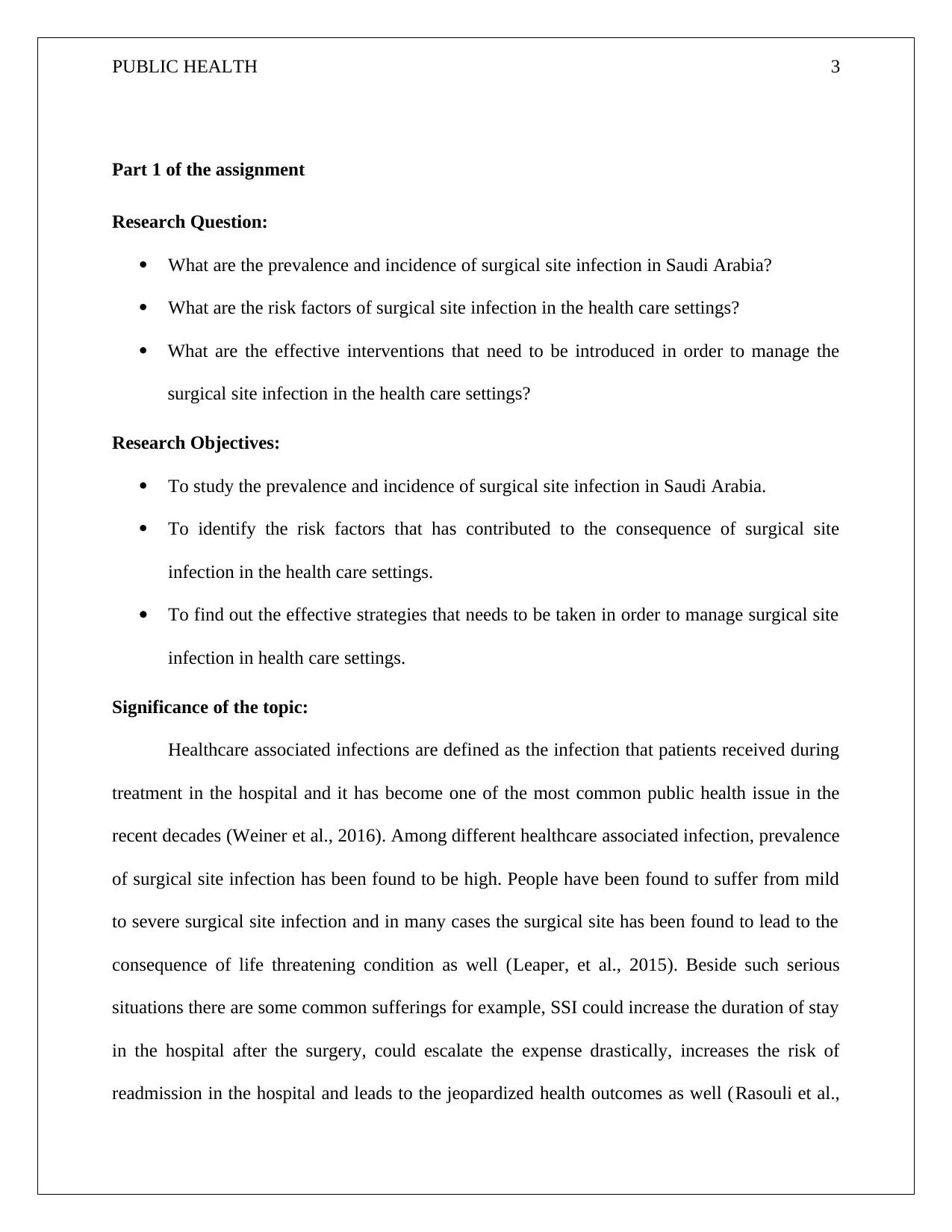
PUBLIC HEALTH 3
Part 1 of the assignment
Research Question:
What are the prevalence and incidence of surgical site infection in Saudi Arabia?
What are the risk factors of surgical site infection in the health care settings?
What are the effective interventions that need to be introduced in order to manage the
surgical site infection in the health care settings?
Research Objectives:
To study the prevalence and incidence of surgical site infection in Saudi Arabia.
To identify the risk factors that has contributed to the consequence of surgical site
infection in the health care settings.
To find out the effective strategies that needs to be taken in order to manage surgical site
infection in health care settings.
Significance of the topic:
Healthcare associated infections are defined as the infection that patients received during
treatment in the hospital and it has become one of the most common public health issue in the
recent decades (Weiner et al., 2016). Among different healthcare associated infection, prevalence
of surgical site infection has been found to be high. People have been found to suffer from mild
to severe surgical site infection and in many cases the surgical site has been found to lead to the
consequence of life threatening condition as well (Leaper, et al., 2015). Beside such serious
situations there are some common sufferings for example, SSI could increase the duration of stay
in the hospital after the surgery, could escalate the expense drastically, increases the risk of
readmission in the hospital and leads to the jeopardized health outcomes as well (Rasouli et al.,
Part 1 of the assignment
Research Question:
What are the prevalence and incidence of surgical site infection in Saudi Arabia?
What are the risk factors of surgical site infection in the health care settings?
What are the effective interventions that need to be introduced in order to manage the
surgical site infection in the health care settings?
Research Objectives:
To study the prevalence and incidence of surgical site infection in Saudi Arabia.
To identify the risk factors that has contributed to the consequence of surgical site
infection in the health care settings.
To find out the effective strategies that needs to be taken in order to manage surgical site
infection in health care settings.
Significance of the topic:
Healthcare associated infections are defined as the infection that patients received during
treatment in the hospital and it has become one of the most common public health issue in the
recent decades (Weiner et al., 2016). Among different healthcare associated infection, prevalence
of surgical site infection has been found to be high. People have been found to suffer from mild
to severe surgical site infection and in many cases the surgical site has been found to lead to the
consequence of life threatening condition as well (Leaper, et al., 2015). Beside such serious
situations there are some common sufferings for example, SSI could increase the duration of stay
in the hospital after the surgery, could escalate the expense drastically, increases the risk of
readmission in the hospital and leads to the jeopardized health outcomes as well (Rasouli et al.,
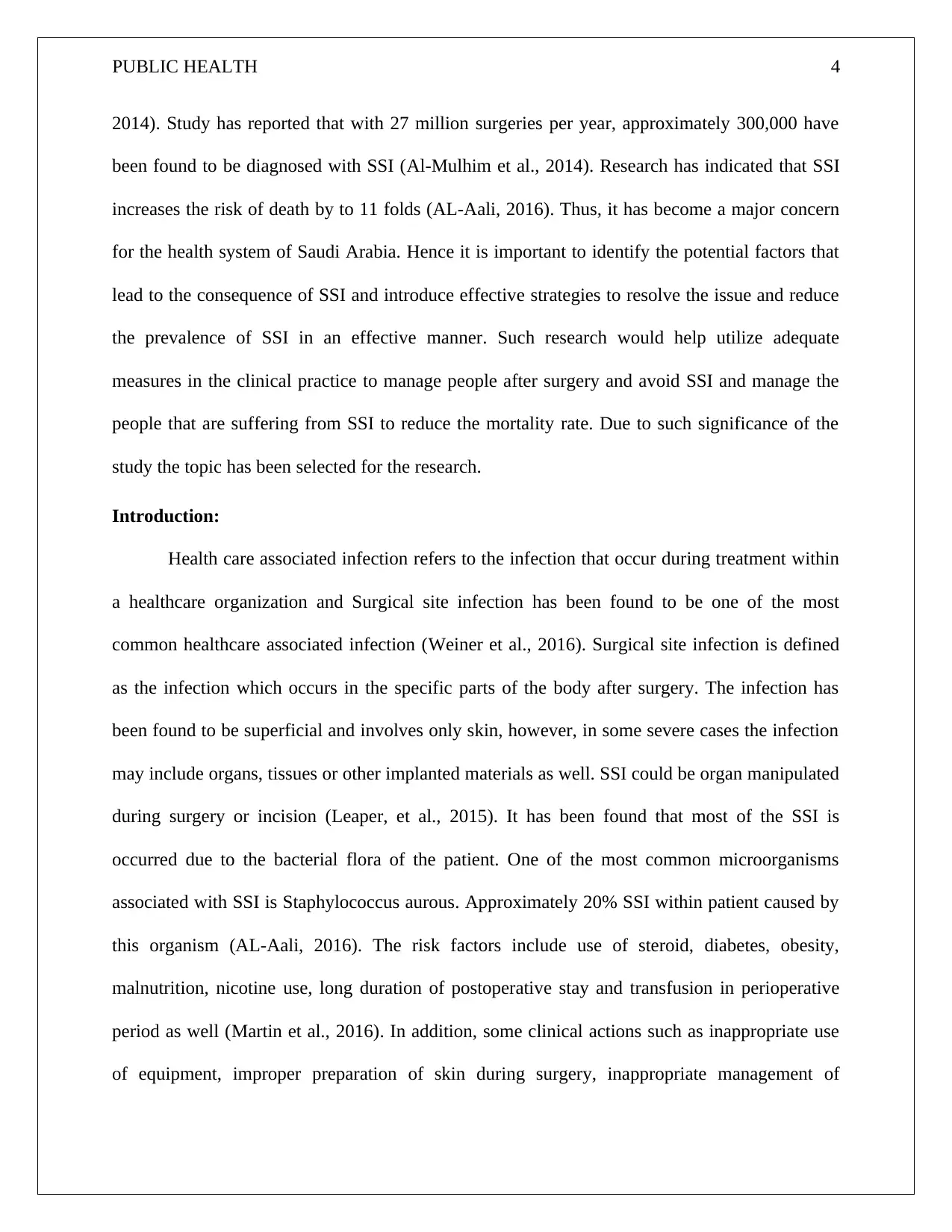
PUBLIC HEALTH 4
2014). Study has reported that with 27 million surgeries per year, approximately 300,000 have
been found to be diagnosed with SSI (Al-Mulhim et al., 2014). Research has indicated that SSI
increases the risk of death by to 11 folds (AL-Aali, 2016). Thus, it has become a major concern
for the health system of Saudi Arabia. Hence it is important to identify the potential factors that
lead to the consequence of SSI and introduce effective strategies to resolve the issue and reduce
the prevalence of SSI in an effective manner. Such research would help utilize adequate
measures in the clinical practice to manage people after surgery and avoid SSI and manage the
people that are suffering from SSI to reduce the mortality rate. Due to such significance of the
study the topic has been selected for the research.
Introduction:
Health care associated infection refers to the infection that occur during treatment within
a healthcare organization and Surgical site infection has been found to be one of the most
common healthcare associated infection (Weiner et al., 2016). Surgical site infection is defined
as the infection which occurs in the specific parts of the body after surgery. The infection has
been found to be superficial and involves only skin, however, in some severe cases the infection
may include organs, tissues or other implanted materials as well. SSI could be organ manipulated
during surgery or incision (Leaper, et al., 2015). It has been found that most of the SSI is
occurred due to the bacterial flora of the patient. One of the most common microorganisms
associated with SSI is Staphylococcus aurous. Approximately 20% SSI within patient caused by
this organism (AL-Aali, 2016). The risk factors include use of steroid, diabetes, obesity,
malnutrition, nicotine use, long duration of postoperative stay and transfusion in perioperative
period as well (Martin et al., 2016). In addition, some clinical actions such as inappropriate use
of equipment, improper preparation of skin during surgery, inappropriate management of
2014). Study has reported that with 27 million surgeries per year, approximately 300,000 have
been found to be diagnosed with SSI (Al-Mulhim et al., 2014). Research has indicated that SSI
increases the risk of death by to 11 folds (AL-Aali, 2016). Thus, it has become a major concern
for the health system of Saudi Arabia. Hence it is important to identify the potential factors that
lead to the consequence of SSI and introduce effective strategies to resolve the issue and reduce
the prevalence of SSI in an effective manner. Such research would help utilize adequate
measures in the clinical practice to manage people after surgery and avoid SSI and manage the
people that are suffering from SSI to reduce the mortality rate. Due to such significance of the
study the topic has been selected for the research.
Introduction:
Health care associated infection refers to the infection that occur during treatment within
a healthcare organization and Surgical site infection has been found to be one of the most
common healthcare associated infection (Weiner et al., 2016). Surgical site infection is defined
as the infection which occurs in the specific parts of the body after surgery. The infection has
been found to be superficial and involves only skin, however, in some severe cases the infection
may include organs, tissues or other implanted materials as well. SSI could be organ manipulated
during surgery or incision (Leaper, et al., 2015). It has been found that most of the SSI is
occurred due to the bacterial flora of the patient. One of the most common microorganisms
associated with SSI is Staphylococcus aurous. Approximately 20% SSI within patient caused by
this organism (AL-Aali, 2016). The risk factors include use of steroid, diabetes, obesity,
malnutrition, nicotine use, long duration of postoperative stay and transfusion in perioperative
period as well (Martin et al., 2016). In addition, some clinical actions such as inappropriate use
of equipment, improper preparation of skin during surgery, inappropriate management of
Secure Best Marks with AI Grader
Need help grading? Try our AI Grader for instant feedback on your assignments.
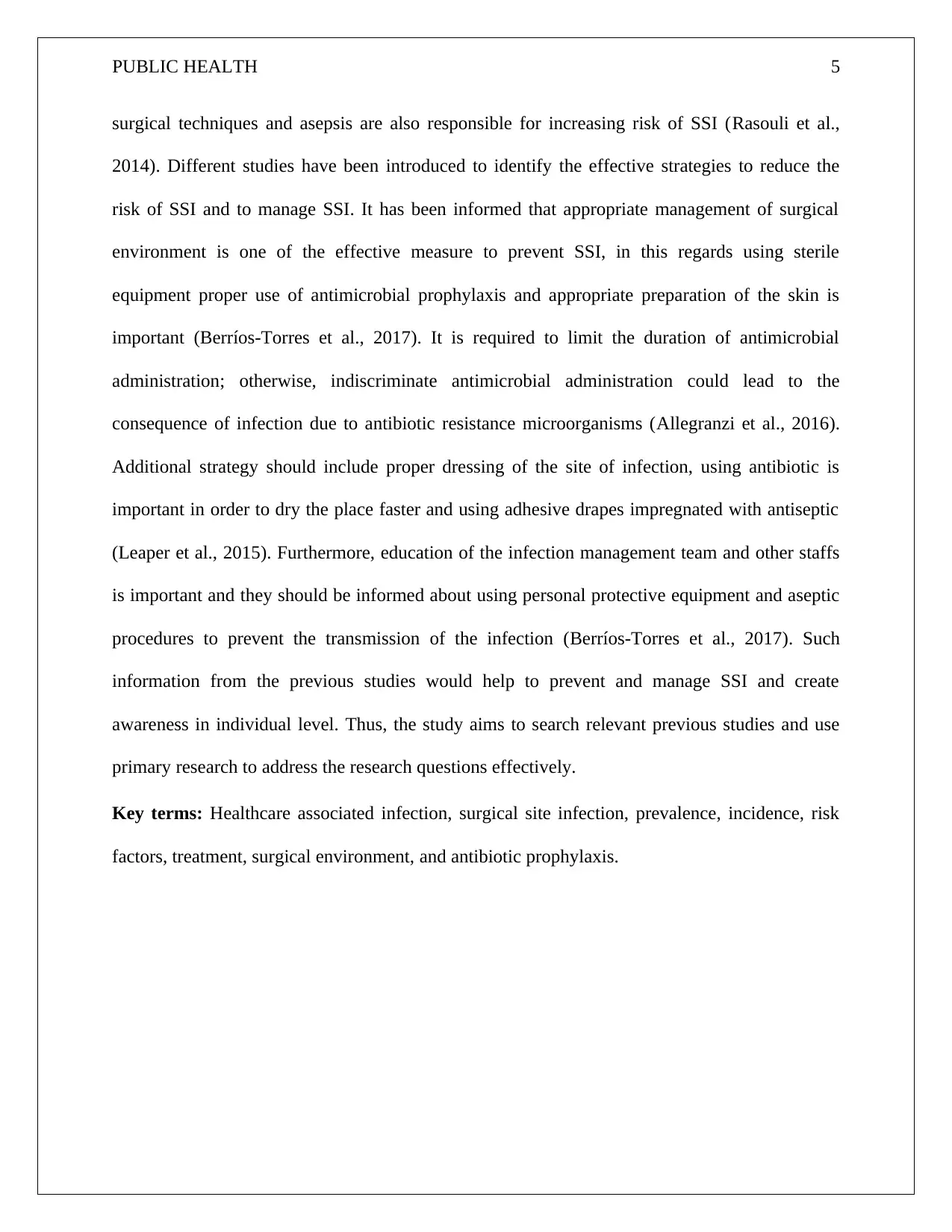
PUBLIC HEALTH 5
surgical techniques and asepsis are also responsible for increasing risk of SSI (Rasouli et al.,
2014). Different studies have been introduced to identify the effective strategies to reduce the
risk of SSI and to manage SSI. It has been informed that appropriate management of surgical
environment is one of the effective measure to prevent SSI, in this regards using sterile
equipment proper use of antimicrobial prophylaxis and appropriate preparation of the skin is
important (Berríos-Torres et al., 2017). It is required to limit the duration of antimicrobial
administration; otherwise, indiscriminate antimicrobial administration could lead to the
consequence of infection due to antibiotic resistance microorganisms (Allegranzi et al., 2016).
Additional strategy should include proper dressing of the site of infection, using antibiotic is
important in order to dry the place faster and using adhesive drapes impregnated with antiseptic
(Leaper et al., 2015). Furthermore, education of the infection management team and other staffs
is important and they should be informed about using personal protective equipment and aseptic
procedures to prevent the transmission of the infection (Berríos-Torres et al., 2017). Such
information from the previous studies would help to prevent and manage SSI and create
awareness in individual level. Thus, the study aims to search relevant previous studies and use
primary research to address the research questions effectively.
Key terms: Healthcare associated infection, surgical site infection, prevalence, incidence, risk
factors, treatment, surgical environment, and antibiotic prophylaxis.
surgical techniques and asepsis are also responsible for increasing risk of SSI (Rasouli et al.,
2014). Different studies have been introduced to identify the effective strategies to reduce the
risk of SSI and to manage SSI. It has been informed that appropriate management of surgical
environment is one of the effective measure to prevent SSI, in this regards using sterile
equipment proper use of antimicrobial prophylaxis and appropriate preparation of the skin is
important (Berríos-Torres et al., 2017). It is required to limit the duration of antimicrobial
administration; otherwise, indiscriminate antimicrobial administration could lead to the
consequence of infection due to antibiotic resistance microorganisms (Allegranzi et al., 2016).
Additional strategy should include proper dressing of the site of infection, using antibiotic is
important in order to dry the place faster and using adhesive drapes impregnated with antiseptic
(Leaper et al., 2015). Furthermore, education of the infection management team and other staffs
is important and they should be informed about using personal protective equipment and aseptic
procedures to prevent the transmission of the infection (Berríos-Torres et al., 2017). Such
information from the previous studies would help to prevent and manage SSI and create
awareness in individual level. Thus, the study aims to search relevant previous studies and use
primary research to address the research questions effectively.
Key terms: Healthcare associated infection, surgical site infection, prevalence, incidence, risk
factors, treatment, surgical environment, and antibiotic prophylaxis.
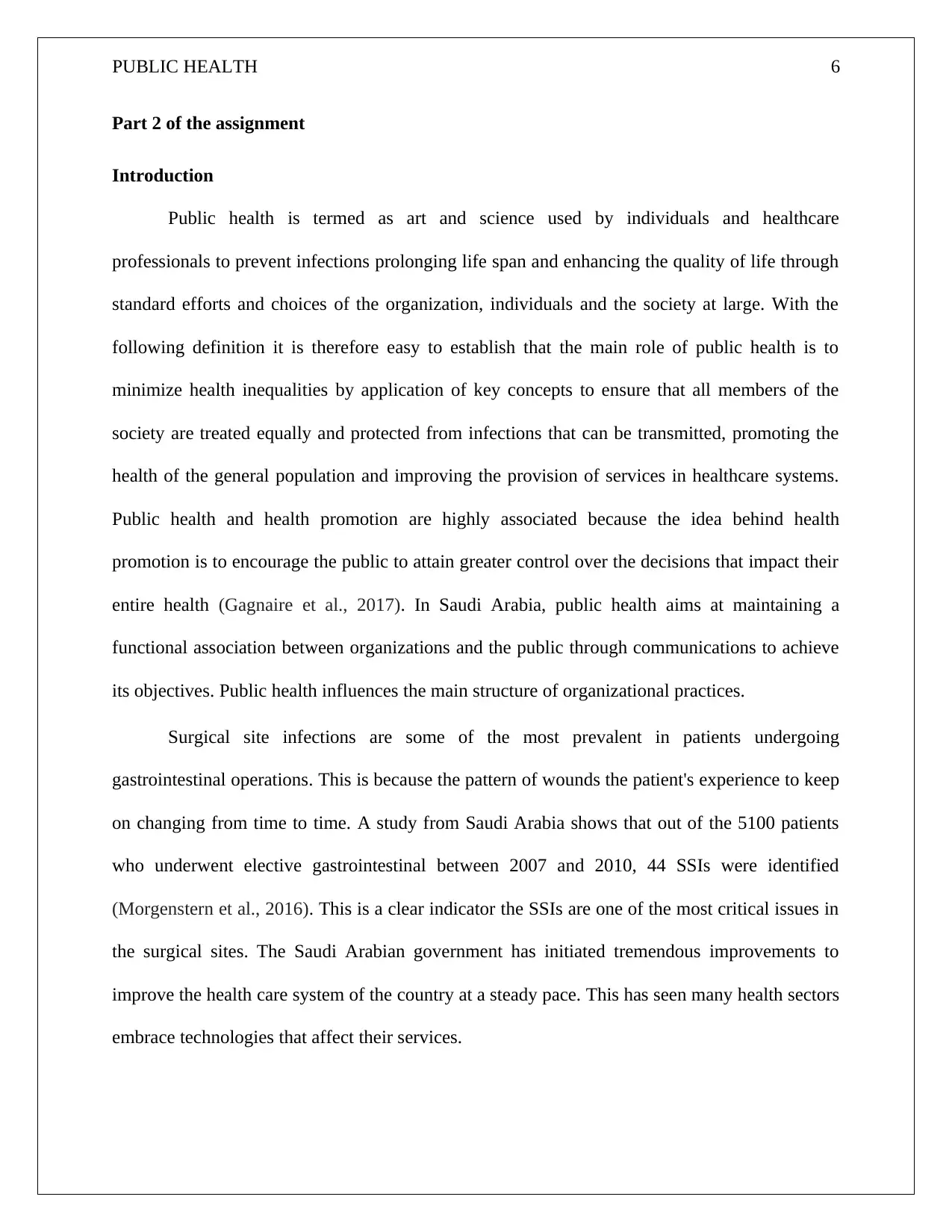
PUBLIC HEALTH 6
Part 2 of the assignment
Introduction
Public health is termed as art and science used by individuals and healthcare
professionals to prevent infections prolonging life span and enhancing the quality of life through
standard efforts and choices of the organization, individuals and the society at large. With the
following definition it is therefore easy to establish that the main role of public health is to
minimize health inequalities by application of key concepts to ensure that all members of the
society are treated equally and protected from infections that can be transmitted, promoting the
health of the general population and improving the provision of services in healthcare systems.
Public health and health promotion are highly associated because the idea behind health
promotion is to encourage the public to attain greater control over the decisions that impact their
entire health (Gagnaire et al., 2017). In Saudi Arabia, public health aims at maintaining a
functional association between organizations and the public through communications to achieve
its objectives. Public health influences the main structure of organizational practices.
Surgical site infections are some of the most prevalent in patients undergoing
gastrointestinal operations. This is because the pattern of wounds the patient's experience to keep
on changing from time to time. A study from Saudi Arabia shows that out of the 5100 patients
who underwent elective gastrointestinal between 2007 and 2010, 44 SSIs were identified
(Morgenstern et al., 2016). This is a clear indicator the SSIs are one of the most critical issues in
the surgical sites. The Saudi Arabian government has initiated tremendous improvements to
improve the health care system of the country at a steady pace. This has seen many health sectors
embrace technologies that affect their services.
Part 2 of the assignment
Introduction
Public health is termed as art and science used by individuals and healthcare
professionals to prevent infections prolonging life span and enhancing the quality of life through
standard efforts and choices of the organization, individuals and the society at large. With the
following definition it is therefore easy to establish that the main role of public health is to
minimize health inequalities by application of key concepts to ensure that all members of the
society are treated equally and protected from infections that can be transmitted, promoting the
health of the general population and improving the provision of services in healthcare systems.
Public health and health promotion are highly associated because the idea behind health
promotion is to encourage the public to attain greater control over the decisions that impact their
entire health (Gagnaire et al., 2017). In Saudi Arabia, public health aims at maintaining a
functional association between organizations and the public through communications to achieve
its objectives. Public health influences the main structure of organizational practices.
Surgical site infections are some of the most prevalent in patients undergoing
gastrointestinal operations. This is because the pattern of wounds the patient's experience to keep
on changing from time to time. A study from Saudi Arabia shows that out of the 5100 patients
who underwent elective gastrointestinal between 2007 and 2010, 44 SSIs were identified
(Morgenstern et al., 2016). This is a clear indicator the SSIs are one of the most critical issues in
the surgical sites. The Saudi Arabian government has initiated tremendous improvements to
improve the health care system of the country at a steady pace. This has seen many health sectors
embrace technologies that affect their services.

PUBLIC HEALTH 7
Literature Review
Prevalence and Incidence of Surgical Site Infection in Saudi Arabia
Surgical site infections have a significant influence on the morbidity, mortality and
healthcare expenditure of most economies. The worldwide incidence of SSI was 2.55% in 2013
which is below the reported figure of 2.6% to 41.9% in 2015 (Al-Mulhim, Baragbah, Sadat-Ali,
Alomran& Azam, 2014). In Saudi Arabia, most of the patients experiencing surgical site
infections were found to be aged 55 plus years. This shows that SSIs in Saudi Arabia is more
prevalent on the aged people. Also, diabetic people are more likely to experience SSIs because
they may undergo surgeries that cause them these sort of complications (Allegranzi et al., 2016).
Men are as well most affected by SSI because they are addicted to smoking habits that expose
them to the risk of SSIs more than their female counterparts. In a cross-sectional study contacted
across Saudi Arabia, it was found that smoking impairs tissue oxygenation and local hypoxia
through vasoconstriction, therefore, influencing the healing of SSI wounds.
Risk factors for surgical site infection in the healthcare setting
There are multiple risk factors which are related to the development of surgical site
infection (SSI) in various healthcare settings. Risk factors for surgical site infection can be
categorized into modifiable such as weight and non-modifiable such as gender (Namba,
Inacio&Paxton, 2013). Some of the risk factors which can expose a patient to surgical site
infection include obesity which happens mostly after abdominal procedures. Malnutrition is
considered another significant risk factor for SSI. According to recent studies which have been
conducted, nutrition has been recognized as a significant factor for nosocomial infections which
includes surgical site infection among patients who undergo any surgery. Patients, mostly from
Literature Review
Prevalence and Incidence of Surgical Site Infection in Saudi Arabia
Surgical site infections have a significant influence on the morbidity, mortality and
healthcare expenditure of most economies. The worldwide incidence of SSI was 2.55% in 2013
which is below the reported figure of 2.6% to 41.9% in 2015 (Al-Mulhim, Baragbah, Sadat-Ali,
Alomran& Azam, 2014). In Saudi Arabia, most of the patients experiencing surgical site
infections were found to be aged 55 plus years. This shows that SSIs in Saudi Arabia is more
prevalent on the aged people. Also, diabetic people are more likely to experience SSIs because
they may undergo surgeries that cause them these sort of complications (Allegranzi et al., 2016).
Men are as well most affected by SSI because they are addicted to smoking habits that expose
them to the risk of SSIs more than their female counterparts. In a cross-sectional study contacted
across Saudi Arabia, it was found that smoking impairs tissue oxygenation and local hypoxia
through vasoconstriction, therefore, influencing the healing of SSI wounds.
Risk factors for surgical site infection in the healthcare setting
There are multiple risk factors which are related to the development of surgical site
infection (SSI) in various healthcare settings. Risk factors for surgical site infection can be
categorized into modifiable such as weight and non-modifiable such as gender (Namba,
Inacio&Paxton, 2013). Some of the risk factors which can expose a patient to surgical site
infection include obesity which happens mostly after abdominal procedures. Malnutrition is
considered another significant risk factor for SSI. According to recent studies which have been
conducted, nutrition has been recognized as a significant factor for nosocomial infections which
includes surgical site infection among patients who undergo any surgery. Patients, mostly from
Paraphrase This Document
Need a fresh take? Get an instant paraphrase of this document with our AI Paraphraser
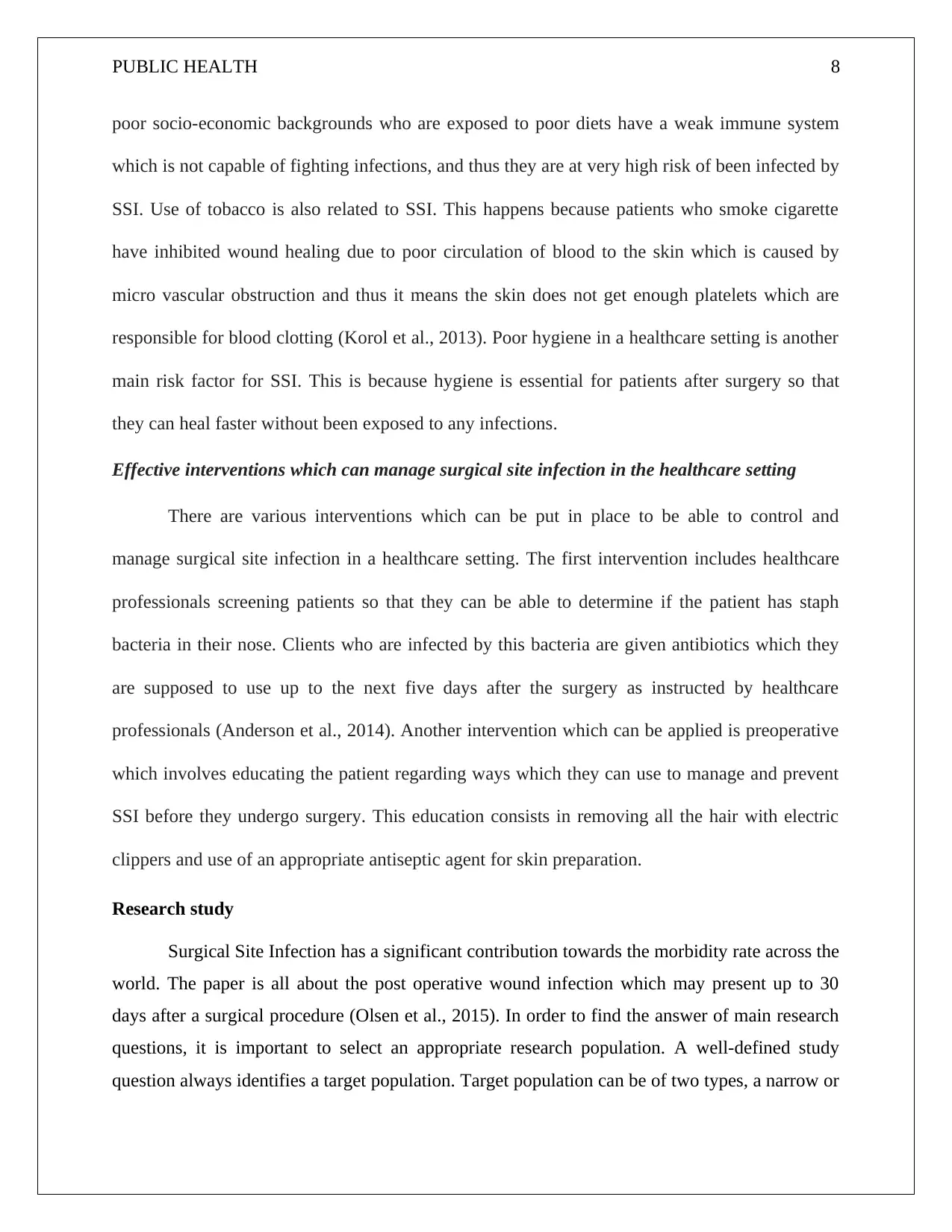
PUBLIC HEALTH 8
poor socio-economic backgrounds who are exposed to poor diets have a weak immune system
which is not capable of fighting infections, and thus they are at very high risk of been infected by
SSI. Use of tobacco is also related to SSI. This happens because patients who smoke cigarette
have inhibited wound healing due to poor circulation of blood to the skin which is caused by
micro vascular obstruction and thus it means the skin does not get enough platelets which are
responsible for blood clotting (Korol et al., 2013). Poor hygiene in a healthcare setting is another
main risk factor for SSI. This is because hygiene is essential for patients after surgery so that
they can heal faster without been exposed to any infections.
Effective interventions which can manage surgical site infection in the healthcare setting
There are various interventions which can be put in place to be able to control and
manage surgical site infection in a healthcare setting. The first intervention includes healthcare
professionals screening patients so that they can be able to determine if the patient has staph
bacteria in their nose. Clients who are infected by this bacteria are given antibiotics which they
are supposed to use up to the next five days after the surgery as instructed by healthcare
professionals (Anderson et al., 2014). Another intervention which can be applied is preoperative
which involves educating the patient regarding ways which they can use to manage and prevent
SSI before they undergo surgery. This education consists in removing all the hair with electric
clippers and use of an appropriate antiseptic agent for skin preparation.
Research study
Surgical Site Infection has a significant contribution towards the morbidity rate across the
world. The paper is all about the post operative wound infection which may present up to 30
days after a surgical procedure (Olsen et al., 2015). In order to find the answer of main research
questions, it is important to select an appropriate research population. A well-defined study
question always identifies a target population. Target population can be of two types, a narrow or
poor socio-economic backgrounds who are exposed to poor diets have a weak immune system
which is not capable of fighting infections, and thus they are at very high risk of been infected by
SSI. Use of tobacco is also related to SSI. This happens because patients who smoke cigarette
have inhibited wound healing due to poor circulation of blood to the skin which is caused by
micro vascular obstruction and thus it means the skin does not get enough platelets which are
responsible for blood clotting (Korol et al., 2013). Poor hygiene in a healthcare setting is another
main risk factor for SSI. This is because hygiene is essential for patients after surgery so that
they can heal faster without been exposed to any infections.
Effective interventions which can manage surgical site infection in the healthcare setting
There are various interventions which can be put in place to be able to control and
manage surgical site infection in a healthcare setting. The first intervention includes healthcare
professionals screening patients so that they can be able to determine if the patient has staph
bacteria in their nose. Clients who are infected by this bacteria are given antibiotics which they
are supposed to use up to the next five days after the surgery as instructed by healthcare
professionals (Anderson et al., 2014). Another intervention which can be applied is preoperative
which involves educating the patient regarding ways which they can use to manage and prevent
SSI before they undergo surgery. This education consists in removing all the hair with electric
clippers and use of an appropriate antiseptic agent for skin preparation.
Research study
Surgical Site Infection has a significant contribution towards the morbidity rate across the
world. The paper is all about the post operative wound infection which may present up to 30
days after a surgical procedure (Olsen et al., 2015). In order to find the answer of main research
questions, it is important to select an appropriate research population. A well-defined study
question always identifies a target population. Target population can be of two types, a narrow or
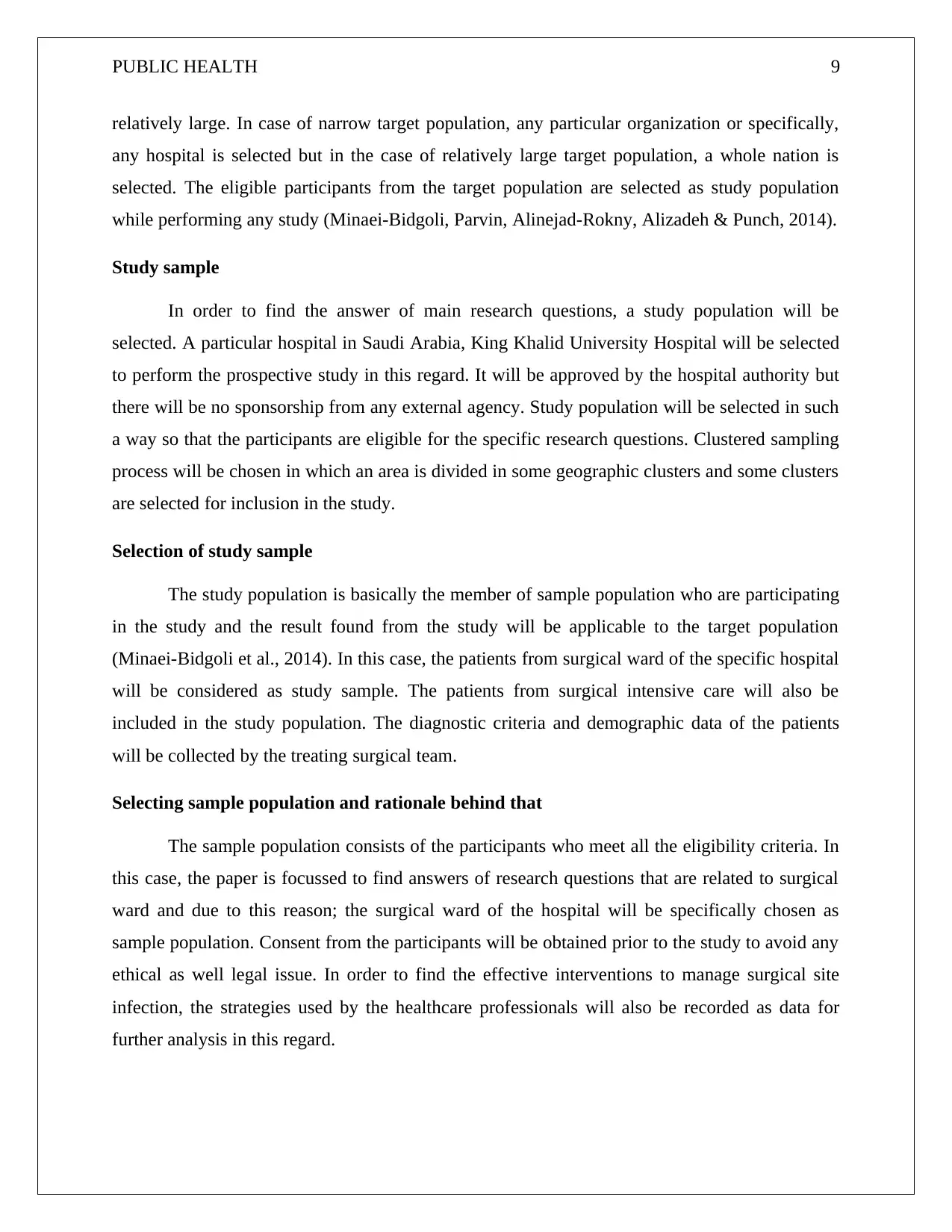
PUBLIC HEALTH 9
relatively large. In case of narrow target population, any particular organization or specifically,
any hospital is selected but in the case of relatively large target population, a whole nation is
selected. The eligible participants from the target population are selected as study population
while performing any study (Minaei-Bidgoli, Parvin, Alinejad-Rokny, Alizadeh & Punch, 2014).
Study sample
In order to find the answer of main research questions, a study population will be
selected. A particular hospital in Saudi Arabia, King Khalid University Hospital will be selected
to perform the prospective study in this regard. It will be approved by the hospital authority but
there will be no sponsorship from any external agency. Study population will be selected in such
a way so that the participants are eligible for the specific research questions. Clustered sampling
process will be chosen in which an area is divided in some geographic clusters and some clusters
are selected for inclusion in the study.
Selection of study sample
The study population is basically the member of sample population who are participating
in the study and the result found from the study will be applicable to the target population
(Minaei-Bidgoli et al., 2014). In this case, the patients from surgical ward of the specific hospital
will be considered as study sample. The patients from surgical intensive care will also be
included in the study population. The diagnostic criteria and demographic data of the patients
will be collected by the treating surgical team.
Selecting sample population and rationale behind that
The sample population consists of the participants who meet all the eligibility criteria. In
this case, the paper is focussed to find answers of research questions that are related to surgical
ward and due to this reason; the surgical ward of the hospital will be specifically chosen as
sample population. Consent from the participants will be obtained prior to the study to avoid any
ethical as well legal issue. In order to find the effective interventions to manage surgical site
infection, the strategies used by the healthcare professionals will also be recorded as data for
further analysis in this regard.
relatively large. In case of narrow target population, any particular organization or specifically,
any hospital is selected but in the case of relatively large target population, a whole nation is
selected. The eligible participants from the target population are selected as study population
while performing any study (Minaei-Bidgoli, Parvin, Alinejad-Rokny, Alizadeh & Punch, 2014).
Study sample
In order to find the answer of main research questions, a study population will be
selected. A particular hospital in Saudi Arabia, King Khalid University Hospital will be selected
to perform the prospective study in this regard. It will be approved by the hospital authority but
there will be no sponsorship from any external agency. Study population will be selected in such
a way so that the participants are eligible for the specific research questions. Clustered sampling
process will be chosen in which an area is divided in some geographic clusters and some clusters
are selected for inclusion in the study.
Selection of study sample
The study population is basically the member of sample population who are participating
in the study and the result found from the study will be applicable to the target population
(Minaei-Bidgoli et al., 2014). In this case, the patients from surgical ward of the specific hospital
will be considered as study sample. The patients from surgical intensive care will also be
included in the study population. The diagnostic criteria and demographic data of the patients
will be collected by the treating surgical team.
Selecting sample population and rationale behind that
The sample population consists of the participants who meet all the eligibility criteria. In
this case, the paper is focussed to find answers of research questions that are related to surgical
ward and due to this reason; the surgical ward of the hospital will be specifically chosen as
sample population. Consent from the participants will be obtained prior to the study to avoid any
ethical as well legal issue. In order to find the effective interventions to manage surgical site
infection, the strategies used by the healthcare professionals will also be recorded as data for
further analysis in this regard.
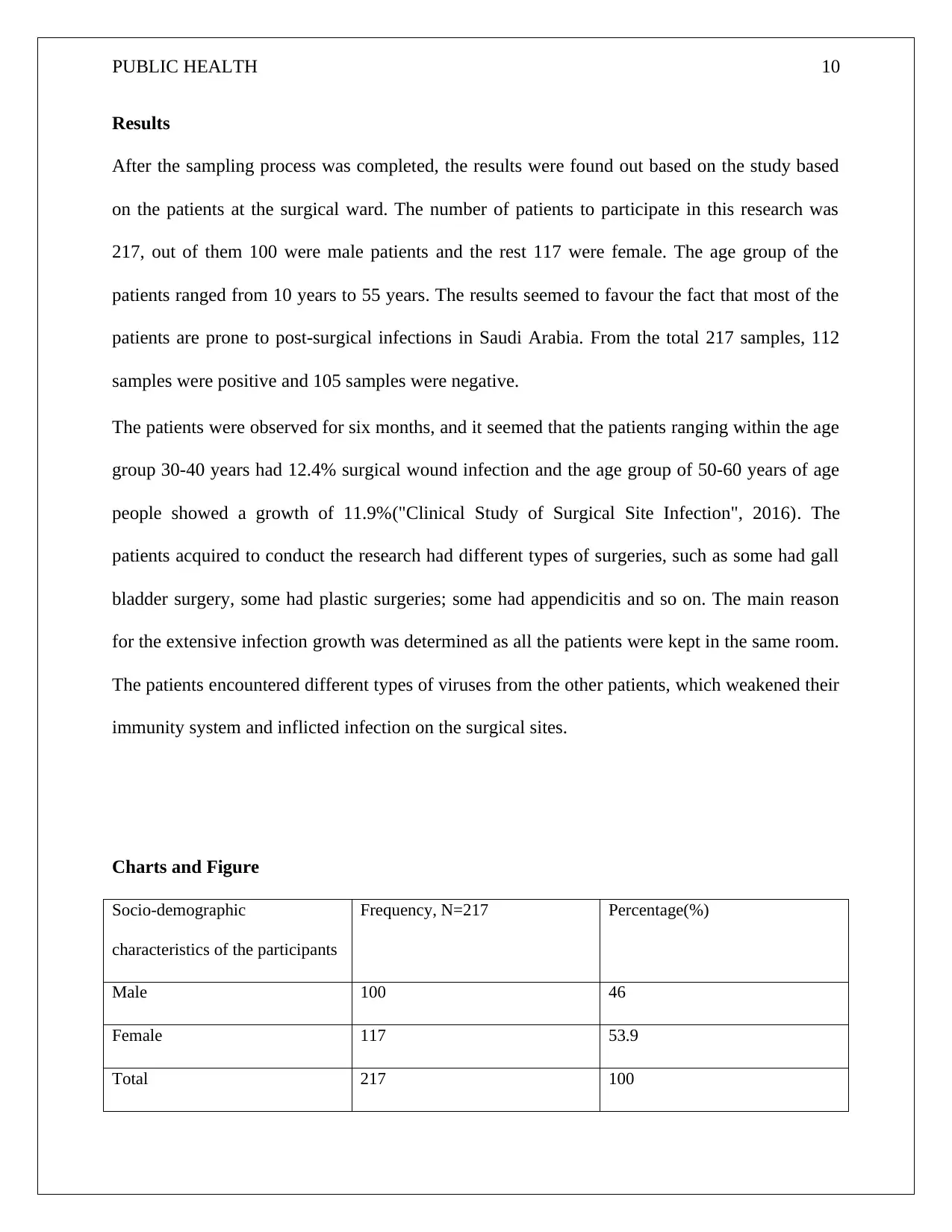
PUBLIC HEALTH 10
Results
After the sampling process was completed, the results were found out based on the study based
on the patients at the surgical ward. The number of patients to participate in this research was
217, out of them 100 were male patients and the rest 117 were female. The age group of the
patients ranged from 10 years to 55 years. The results seemed to favour the fact that most of the
patients are prone to post-surgical infections in Saudi Arabia. From the total 217 samples, 112
samples were positive and 105 samples were negative.
The patients were observed for six months, and it seemed that the patients ranging within the age
group 30-40 years had 12.4% surgical wound infection and the age group of 50-60 years of age
people showed a growth of 11.9%("Clinical Study of Surgical Site Infection", 2016). The
patients acquired to conduct the research had different types of surgeries, such as some had gall
bladder surgery, some had plastic surgeries; some had appendicitis and so on. The main reason
for the extensive infection growth was determined as all the patients were kept in the same room.
The patients encountered different types of viruses from the other patients, which weakened their
immunity system and inflicted infection on the surgical sites.
Charts and Figure
Socio-demographic
characteristics of the participants
Frequency, N=217 Percentage(%)
Male 100 46
Female 117 53.9
Total 217 100
Results
After the sampling process was completed, the results were found out based on the study based
on the patients at the surgical ward. The number of patients to participate in this research was
217, out of them 100 were male patients and the rest 117 were female. The age group of the
patients ranged from 10 years to 55 years. The results seemed to favour the fact that most of the
patients are prone to post-surgical infections in Saudi Arabia. From the total 217 samples, 112
samples were positive and 105 samples were negative.
The patients were observed for six months, and it seemed that the patients ranging within the age
group 30-40 years had 12.4% surgical wound infection and the age group of 50-60 years of age
people showed a growth of 11.9%("Clinical Study of Surgical Site Infection", 2016). The
patients acquired to conduct the research had different types of surgeries, such as some had gall
bladder surgery, some had plastic surgeries; some had appendicitis and so on. The main reason
for the extensive infection growth was determined as all the patients were kept in the same room.
The patients encountered different types of viruses from the other patients, which weakened their
immunity system and inflicted infection on the surgical sites.
Charts and Figure
Socio-demographic
characteristics of the participants
Frequency, N=217 Percentage(%)
Male 100 46
Female 117 53.9
Total 217 100
Secure Best Marks with AI Grader
Need help grading? Try our AI Grader for instant feedback on your assignments.
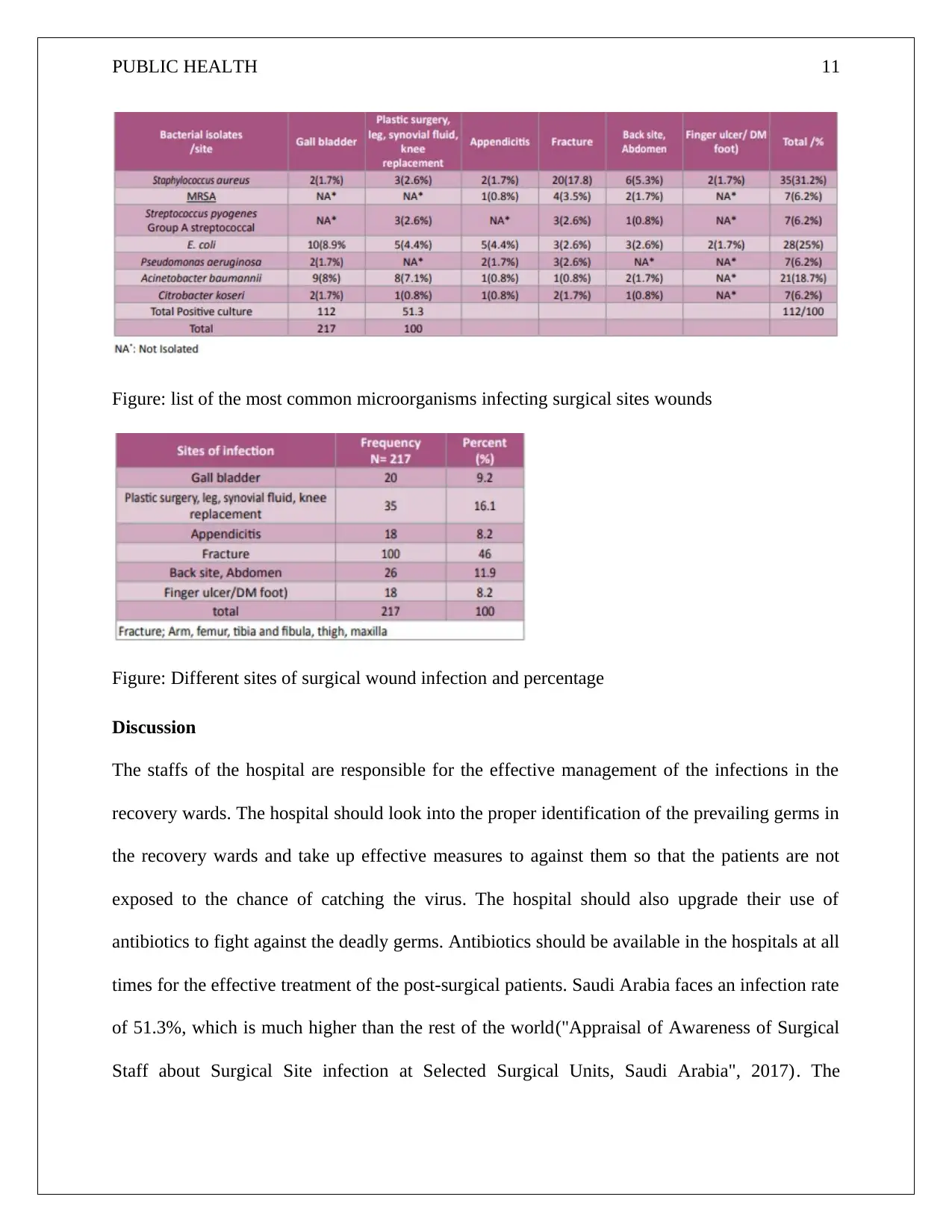
PUBLIC HEALTH 11
Figure: list of the most common microorganisms infecting surgical sites wounds
Figure: Different sites of surgical wound infection and percentage
Discussion
The staffs of the hospital are responsible for the effective management of the infections in the
recovery wards. The hospital should look into the proper identification of the prevailing germs in
the recovery wards and take up effective measures to against them so that the patients are not
exposed to the chance of catching the virus. The hospital should also upgrade their use of
antibiotics to fight against the deadly germs. Antibiotics should be available in the hospitals at all
times for the effective treatment of the post-surgical patients. Saudi Arabia faces an infection rate
of 51.3%, which is much higher than the rest of the world("Appraisal of Awareness of Surgical
Staff about Surgical Site infection at Selected Surgical Units, Saudi Arabia", 2017). The
Figure: list of the most common microorganisms infecting surgical sites wounds
Figure: Different sites of surgical wound infection and percentage
Discussion
The staffs of the hospital are responsible for the effective management of the infections in the
recovery wards. The hospital should look into the proper identification of the prevailing germs in
the recovery wards and take up effective measures to against them so that the patients are not
exposed to the chance of catching the virus. The hospital should also upgrade their use of
antibiotics to fight against the deadly germs. Antibiotics should be available in the hospitals at all
times for the effective treatment of the post-surgical patients. Saudi Arabia faces an infection rate
of 51.3%, which is much higher than the rest of the world("Appraisal of Awareness of Surgical
Staff about Surgical Site infection at Selected Surgical Units, Saudi Arabia", 2017). The

PUBLIC HEALTH 12
literature review part of the research provides enough evidence to support the facts and the
reasons for this growth. Studies show that Surgical Site Infections are more common among the
children and the adults over the age of 55 years. The bacterial infections vary from ward to ward,
based on the activities of the ward, or the type of patients in it. For an instance, the bacteria
S.aureus is most commonly found in the operating rooms. It has been suggested by many doctors
and researchers that advanced surgical techniques can reduce the risk of the post surgery
infections. Recent studies show that a Surgical Site infection is more prevalent with women than
men in Saudi Arabia.
literature review part of the research provides enough evidence to support the facts and the
reasons for this growth. Studies show that Surgical Site Infections are more common among the
children and the adults over the age of 55 years. The bacterial infections vary from ward to ward,
based on the activities of the ward, or the type of patients in it. For an instance, the bacteria
S.aureus is most commonly found in the operating rooms. It has been suggested by many doctors
and researchers that advanced surgical techniques can reduce the risk of the post surgery
infections. Recent studies show that a Surgical Site infection is more prevalent with women than
men in Saudi Arabia.
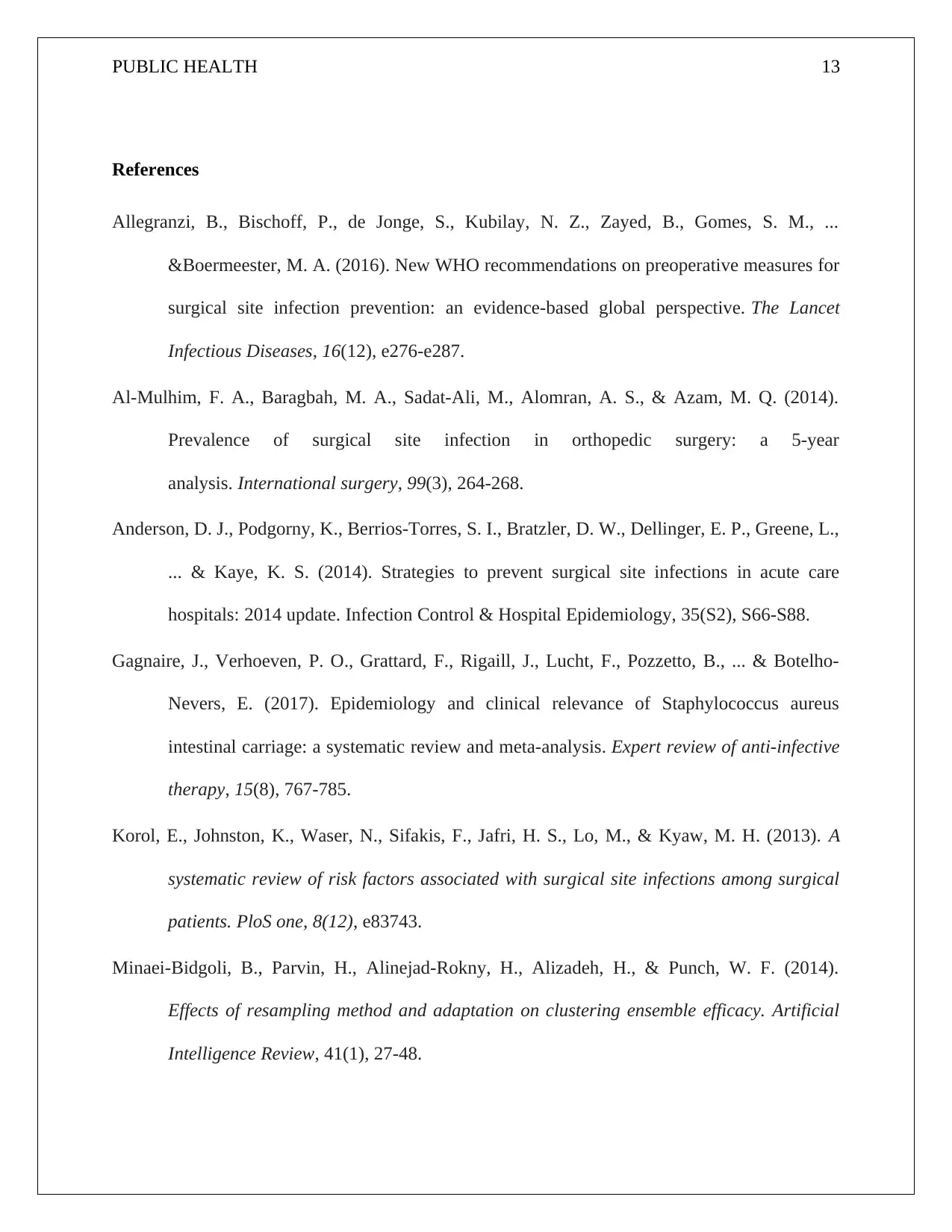
PUBLIC HEALTH 13
References
Allegranzi, B., Bischoff, P., de Jonge, S., Kubilay, N. Z., Zayed, B., Gomes, S. M., ...
&Boermeester, M. A. (2016). New WHO recommendations on preoperative measures for
surgical site infection prevention: an evidence-based global perspective. The Lancet
Infectious Diseases, 16(12), e276-e287.
Al-Mulhim, F. A., Baragbah, M. A., Sadat-Ali, M., Alomran, A. S., & Azam, M. Q. (2014).
Prevalence of surgical site infection in orthopedic surgery: a 5-year
analysis. International surgery, 99(3), 264-268.
Anderson, D. J., Podgorny, K., Berrios-Torres, S. I., Bratzler, D. W., Dellinger, E. P., Greene, L.,
... & Kaye, K. S. (2014). Strategies to prevent surgical site infections in acute care
hospitals: 2014 update. Infection Control & Hospital Epidemiology, 35(S2), S66-S88.
Gagnaire, J., Verhoeven, P. O., Grattard, F., Rigaill, J., Lucht, F., Pozzetto, B., ... & Botelho-
Nevers, E. (2017). Epidemiology and clinical relevance of Staphylococcus aureus
intestinal carriage: a systematic review and meta-analysis. Expert review of anti-infective
therapy, 15(8), 767-785.
Korol, E., Johnston, K., Waser, N., Sifakis, F., Jafri, H. S., Lo, M., & Kyaw, M. H. (2013). A
systematic review of risk factors associated with surgical site infections among surgical
patients. PloS one, 8(12), e83743.
Minaei-Bidgoli, B., Parvin, H., Alinejad-Rokny, H., Alizadeh, H., & Punch, W. F. (2014).
Effects of resampling method and adaptation on clustering ensemble efficacy. Artificial
Intelligence Review, 41(1), 27-48.
References
Allegranzi, B., Bischoff, P., de Jonge, S., Kubilay, N. Z., Zayed, B., Gomes, S. M., ...
&Boermeester, M. A. (2016). New WHO recommendations on preoperative measures for
surgical site infection prevention: an evidence-based global perspective. The Lancet
Infectious Diseases, 16(12), e276-e287.
Al-Mulhim, F. A., Baragbah, M. A., Sadat-Ali, M., Alomran, A. S., & Azam, M. Q. (2014).
Prevalence of surgical site infection in orthopedic surgery: a 5-year
analysis. International surgery, 99(3), 264-268.
Anderson, D. J., Podgorny, K., Berrios-Torres, S. I., Bratzler, D. W., Dellinger, E. P., Greene, L.,
... & Kaye, K. S. (2014). Strategies to prevent surgical site infections in acute care
hospitals: 2014 update. Infection Control & Hospital Epidemiology, 35(S2), S66-S88.
Gagnaire, J., Verhoeven, P. O., Grattard, F., Rigaill, J., Lucht, F., Pozzetto, B., ... & Botelho-
Nevers, E. (2017). Epidemiology and clinical relevance of Staphylococcus aureus
intestinal carriage: a systematic review and meta-analysis. Expert review of anti-infective
therapy, 15(8), 767-785.
Korol, E., Johnston, K., Waser, N., Sifakis, F., Jafri, H. S., Lo, M., & Kyaw, M. H. (2013). A
systematic review of risk factors associated with surgical site infections among surgical
patients. PloS one, 8(12), e83743.
Minaei-Bidgoli, B., Parvin, H., Alinejad-Rokny, H., Alizadeh, H., & Punch, W. F. (2014).
Effects of resampling method and adaptation on clustering ensemble efficacy. Artificial
Intelligence Review, 41(1), 27-48.
Paraphrase This Document
Need a fresh take? Get an instant paraphrase of this document with our AI Paraphraser
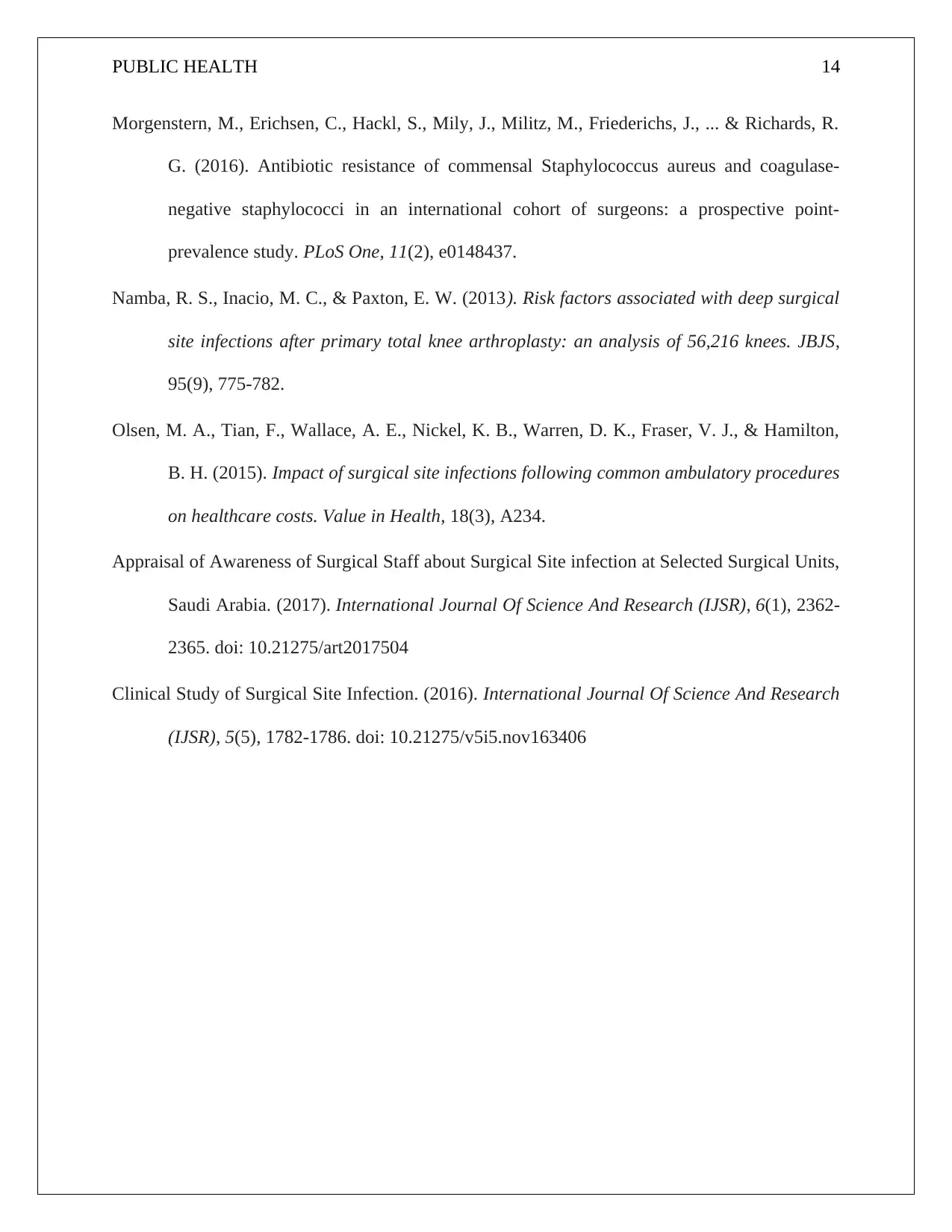
PUBLIC HEALTH 14
Morgenstern, M., Erichsen, C., Hackl, S., Mily, J., Militz, M., Friederichs, J., ... & Richards, R.
G. (2016). Antibiotic resistance of commensal Staphylococcus aureus and coagulase-
negative staphylococci in an international cohort of surgeons: a prospective point-
prevalence study. PLoS One, 11(2), e0148437.
Namba, R. S., Inacio, M. C., & Paxton, E. W. (2013). Risk factors associated with deep surgical
site infections after primary total knee arthroplasty: an analysis of 56,216 knees. JBJS,
95(9), 775-782.
Olsen, M. A., Tian, F., Wallace, A. E., Nickel, K. B., Warren, D. K., Fraser, V. J., & Hamilton,
B. H. (2015). Impact of surgical site infections following common ambulatory procedures
on healthcare costs. Value in Health, 18(3), A234.
Appraisal of Awareness of Surgical Staff about Surgical Site infection at Selected Surgical Units,
Saudi Arabia. (2017). International Journal Of Science And Research (IJSR), 6(1), 2362-
2365. doi: 10.21275/art2017504
Clinical Study of Surgical Site Infection. (2016). International Journal Of Science And Research
(IJSR), 5(5), 1782-1786. doi: 10.21275/v5i5.nov163406
Morgenstern, M., Erichsen, C., Hackl, S., Mily, J., Militz, M., Friederichs, J., ... & Richards, R.
G. (2016). Antibiotic resistance of commensal Staphylococcus aureus and coagulase-
negative staphylococci in an international cohort of surgeons: a prospective point-
prevalence study. PLoS One, 11(2), e0148437.
Namba, R. S., Inacio, M. C., & Paxton, E. W. (2013). Risk factors associated with deep surgical
site infections after primary total knee arthroplasty: an analysis of 56,216 knees. JBJS,
95(9), 775-782.
Olsen, M. A., Tian, F., Wallace, A. E., Nickel, K. B., Warren, D. K., Fraser, V. J., & Hamilton,
B. H. (2015). Impact of surgical site infections following common ambulatory procedures
on healthcare costs. Value in Health, 18(3), A234.
Appraisal of Awareness of Surgical Staff about Surgical Site infection at Selected Surgical Units,
Saudi Arabia. (2017). International Journal Of Science And Research (IJSR), 6(1), 2362-
2365. doi: 10.21275/art2017504
Clinical Study of Surgical Site Infection. (2016). International Journal Of Science And Research
(IJSR), 5(5), 1782-1786. doi: 10.21275/v5i5.nov163406

PUBLIC HEALTH 15
Glossary
SSI: Full form- Surgical Site Infection. Surgical site infection is the infection, which happens
post-surgery on the area where the surgery takes place. Sometimes the infections are superficial
but sometimes they involve sensitive organs and are fatal for the patient.
Glossary
SSI: Full form- Surgical Site Infection. Surgical site infection is the infection, which happens
post-surgery on the area where the surgery takes place. Sometimes the infections are superficial
but sometimes they involve sensitive organs and are fatal for the patient.
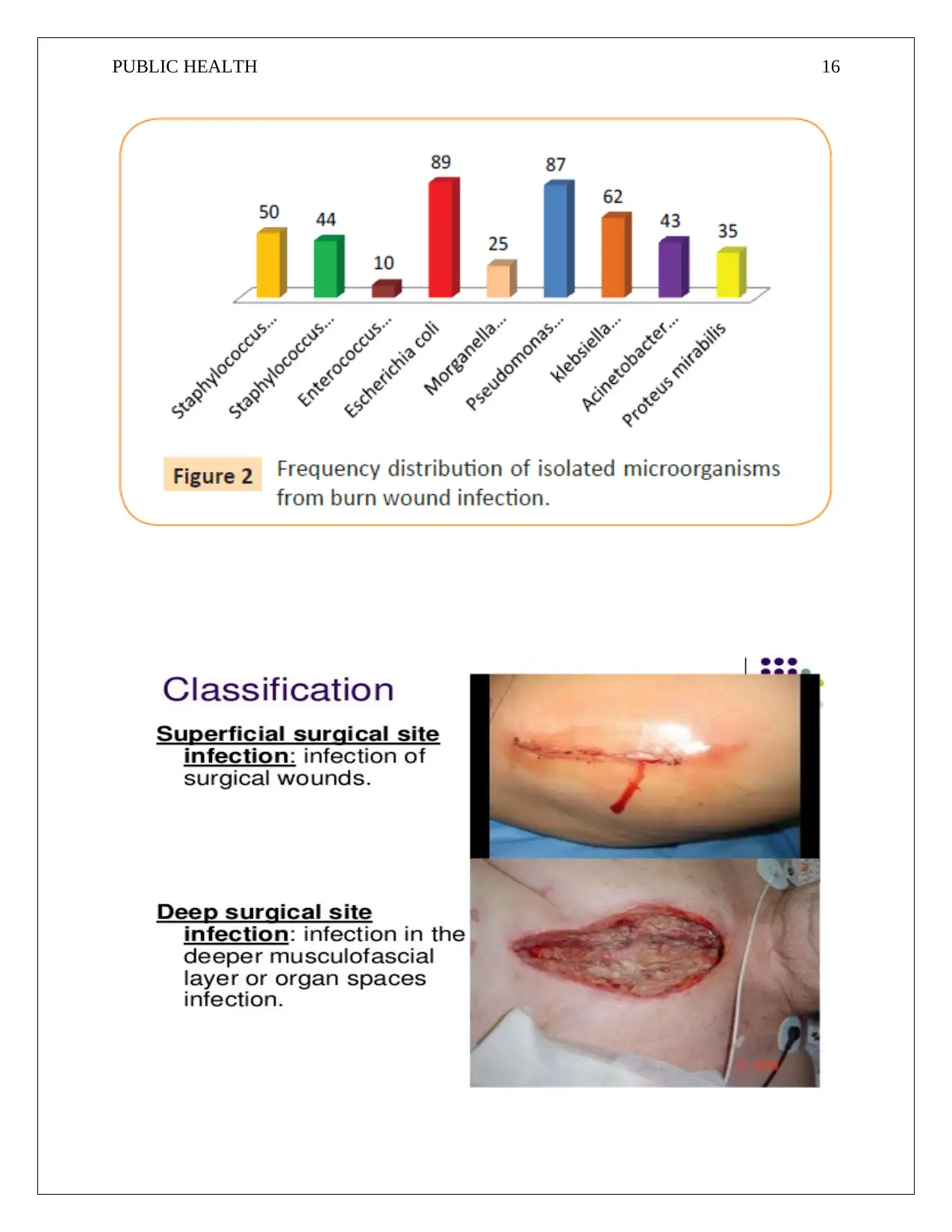
PUBLIC HEALTH 16
Secure Best Marks with AI Grader
Need help grading? Try our AI Grader for instant feedback on your assignments.
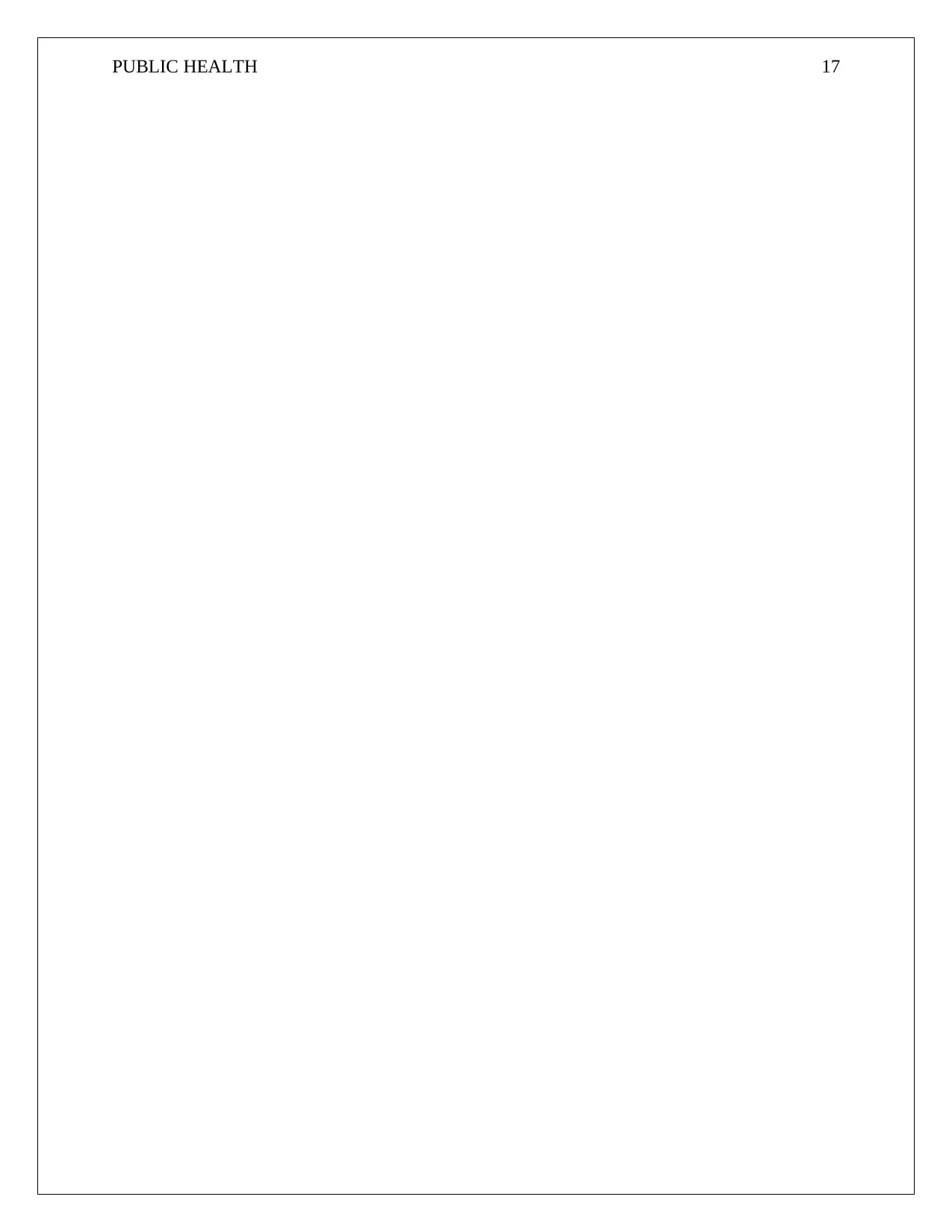
PUBLIC HEALTH 17
1 out of 17
Related Documents
Your All-in-One AI-Powered Toolkit for Academic Success.
+13062052269
info@desklib.com
Available 24*7 on WhatsApp / Email
![[object Object]](/_next/static/media/star-bottom.7253800d.svg)
Unlock your academic potential
© 2024 | Zucol Services PVT LTD | All rights reserved.




